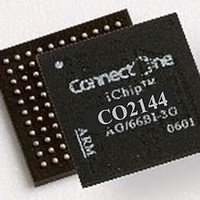CO2144/48LI-3 Connect One, CO2144/48LI-3 Datasheet - Page 31

CO2144/48LI-3
Manufacturer Part Number
CO2144/48LI-3
Description
Ethernet ICs CO2144 LFBGA FORM FACTOR
Manufacturer
Connect One
Datasheet
1.CO214448LI-3SP.pdf
(63 pages)
Specifications of CO2144/48LI-3
Ethernet Connection Type
10/100 BaseT LAN
Maximum Power Dissipation
200 mW
Minimum Operating Temperature
- 40 C
Mounting Style
SMD/SMT
Product
Ethernet Controllers
Standard Supported
802.11b/g
Data Rate
2.4 Kbps to 3 Mbps
Supply Voltage (max)
3.3 V
Supply Voltage (min)
1.2 V
Maximum Operating Temperature
+ 85 C
Package / Case
LQFP-144
Lead Free Status / RoHS Status
Lead free / RoHS Compliant
Available stocks
Company
Part Number
Manufacturer
Quantity
Price
Company:
Part Number:
CO2144/48LI-3
Manufacturer:
ConnectO
Quantity:
168
Company:
Part Number:
CO2144/48LI-3(SP)
Manufacturer:
ConnectO
Quantity:
8
Connect One
5.2 Technical Specifications
5.2.1 General
iChip constitutes a complete Internet messaging solution for non-PC embedded devices. It
acts as a mediator device to completely offload the host processor of Internet -related
software and activities. One of several local communication links may be used to connect
iChip to the host processor:
Programming, monitoring and control are fully supported using Connect One‘s AT+i
extension to the standard AT command set.
iChip connects to land-line or cellular modems and to an Ethernet PHY or WiFi chipset for
Internet access. An AT+i command is provided to switch between the modem and
Ethernet/WiFi.
5.2.2 Firmware Upload
iChip is based on an internal ROM-based boot loader and internal SRAM used for its
functional implementation. The device does not include internal flash memory. As a result,
iChip is designed to accept a firmware upload, using its built-in boot loader, after each power-
on cycle. In addition, the CO2128/CO2144 have an external bus that allows them to run from
an external memory device (such as flash).
iChip can receive the firmware upload from a series of interfaces, allowing embedded system
designers a wide choice of alternatives that best suit each application.
iChip firmware sources are separated into two distinct categories: passive sources and active
sources. Passive sources are generally storage devices, such as flash, EPROM or battery -
backed RAM that are connected to iChip. iChip‘s boot loader detects passive sources and
attempts to upload its firmware by directly accessing these devices. Active sources are
envisioned to be other processor based devices that communicate with iChip over one of its
available interfaces and actively download iChip‘s firmware.
Note that, in each application, only one firmware source need be employed.
5.2.2.1
iChip CO2128/CO2144 support any memory device, such as flash, EPROM, EEPROM,
battery-backed RAM, etc. that are attached and configured on their 16-bit local bus or SPI
interface. iChip supports memory devices attached to the SPI interface. When a passive
device is connected, iChip‘s boot loader detects it, uploads its firmware, and starts execution.
In the case of CO2128/CO2144, a dedicated pin may be tied LOW during power on reset to
force iChip to begin executing from a memory device configured on its external bus, rather
than uploading firmware into its internal SRAM.
5.2.2.2
When passive devices are not detected, iChip waits for an active device over any one of its
available interfaces. These include:
iChip CO2064/CO2128/CO2144 Data Sheet
An industry-standard asynchronous serial link
TWI
SPI
USB
High-speed 8-bit parallel port
USARTs
Passive Devices
Active Devices
Functional Description
TM
5-2















